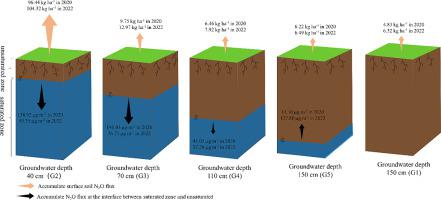当前位置:
X-MOL 学术
›
Sci. Total Environ.
›
论文详情
Our official English website, www.x-mol.net, welcomes your feedback! (Note: you will need to create a separate account there.)
Influences of shallow groundwater depth on N2O diffusion along the soil profile of summer maize fields in North China Plain
Science of the Total Environment ( IF 9.8 ) Pub Date : 2024-03-20 , DOI: 10.1016/j.scitotenv.2024.171861 Zhao Li , Xurun Li , Qiuying Zhang , Fadong Li , Yunfeng Qiao , Shanbao Liu , Peifang Leng , Chao Tian , Gang Chen , Hefa Cheng
Science of the Total Environment ( IF 9.8 ) Pub Date : 2024-03-20 , DOI: 10.1016/j.scitotenv.2024.171861 Zhao Li , Xurun Li , Qiuying Zhang , Fadong Li , Yunfeng Qiao , Shanbao Liu , Peifang Leng , Chao Tian , Gang Chen , Hefa Cheng

|
The emissions of nitrous oxide (NO) from agricultural fields are a significant contribution to global warming. Understanding the mechanisms of NO emissions from agricultural fields is essential for the development of NO emission mitigation strategies. Currently, there are extensive studies on NO emissions on the surface of agricultural soils, while studies on NO fluxes at the interface between the saturated and unsaturated zones (ISU) are limited. Uncertainties exist regarding NO emissions from the soil-shallow groundwater systems in agricultural fields. In this study, a three-year lysimeter experiment (2019–2020, 2022) was conducted to simulate the soil-shallow groundwater systems under four controlled shallow groundwater depth (SGD) (i.e., SGD = 40, 70, 110, and 150 cm) conditions in North China Plain (NCP). Weekly continuous monitoring of NO emissions from soil surface, NO concentration in the shallow groundwater and the upper 10 cm of pores at the ISU, and nitrogen cycling-related parameters in the soil and groundwater was conducted. The results showed that soil surface NO emissions increased with decreased shallow groundwater depth, and the highest emissions of 96.44 kg ha and 104.32 kg ha were observed at G2 (SGD = 40 cm) in 2020 and 2022. During the observation period of one maize growing season, shallow groundwater acted as a sink for the unsaturated zone when the groundwater depth was 40 cm, 70 cm, and 110 cm. However, when SGD was 150 cm, shallow groundwater became a source for the unsaturated zone. After fertilization, the groundwater in all treatment plots behaved as a sink for the unsaturated zone, and the diffusion intensity decreased with increasing SGD. The results would provide a theoretical basis for cropland water management to reduce NO emissions.
中文翻译:

华北平原夏玉米田浅层地下水埋深对N2O沿土壤剖面扩散的影响
农田排放的一氧化二氮 (NO) 是导致全球变暖的重要原因。了解农田 N2O 排放的机制对于制定 N2O 减排策略至关重要。目前,人们对农业土壤表面的NO排放进行了广泛的研究,而对饱和区和非饱和区(ISU)界面处的NO通量的研究却很有限。农田土壤浅层地下水系统的二氧化氮排放存在不确定性。本研究进行了为期三年的蒸渗计实验(2019-2020、2022),模拟了四种受控浅层地下水深度(SGD)(即SGD = 40、70、110和150 cm)下的土壤-浅层地下水系统。 )华北平原(NCP)的情况。每周连续监测土壤表面的 NO 排放、ISU 浅层地下水和上部 10 cm 孔隙中的 NO 浓度以及土壤和地下水中氮循环相关参数。结果表明,随着浅层地下水埋深的减小,土壤表面NO排放量增加,2020年和2022年G2(SGD = 40 cm)排放量最高,分别为96.44 kg ha和104.32 kg ha。季节中,当地下水埋深为40 cm、70 cm、110 cm时,浅层地下水作为非饱和带的汇。然而,当SGD为150 cm时,浅层地下水成为非饱和带的水源。施肥后,所有处理样地的地下水均表现为非饱和区的汇,扩散强度随着SGD的增加而减小。研究结果将为农田水管理减少NO排放提供理论依据。
更新日期:2024-03-20
中文翻译:

华北平原夏玉米田浅层地下水埋深对N2O沿土壤剖面扩散的影响
农田排放的一氧化二氮 (NO) 是导致全球变暖的重要原因。了解农田 N2O 排放的机制对于制定 N2O 减排策略至关重要。目前,人们对农业土壤表面的NO排放进行了广泛的研究,而对饱和区和非饱和区(ISU)界面处的NO通量的研究却很有限。农田土壤浅层地下水系统的二氧化氮排放存在不确定性。本研究进行了为期三年的蒸渗计实验(2019-2020、2022),模拟了四种受控浅层地下水深度(SGD)(即SGD = 40、70、110和150 cm)下的土壤-浅层地下水系统。 )华北平原(NCP)的情况。每周连续监测土壤表面的 NO 排放、ISU 浅层地下水和上部 10 cm 孔隙中的 NO 浓度以及土壤和地下水中氮循环相关参数。结果表明,随着浅层地下水埋深的减小,土壤表面NO排放量增加,2020年和2022年G2(SGD = 40 cm)排放量最高,分别为96.44 kg ha和104.32 kg ha。季节中,当地下水埋深为40 cm、70 cm、110 cm时,浅层地下水作为非饱和带的汇。然而,当SGD为150 cm时,浅层地下水成为非饱和带的水源。施肥后,所有处理样地的地下水均表现为非饱和区的汇,扩散强度随着SGD的增加而减小。研究结果将为农田水管理减少NO排放提供理论依据。



























 京公网安备 11010802027423号
京公网安备 11010802027423号